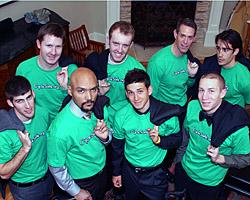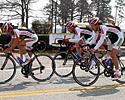
Recently on Cyclingnews.com |

|
Learning curve: The TIME Factory Development team diary 2007
The TIME Factory Development Team isn't your average American elite amateur team. Under the leadership of former pro Erik Saunders, the program has created an environment in which riders can gain the experience, knowledge, and fitness to get results instead of simply tossing riders into races and hoping they succeed.
Along the way, the riders will live, eat, ride and race together as they learn how to become professional bike racers.
For further reading about the team, visit the Time Factory Development Team website.
Culture and planning for the future
By Erik Saunders

|
After a lot of hard work in putting the team together and getting it off the ground I am happy with where we are and also confident that we have the momentum in the organization to function without me having to devote so much time to the small details. It's at this moment that an organization can grow. We had been under a tremendous amount of stress and now things have stabilized under that initial load. We can bear it easily and now Pat Raines, Jamie Bennett, and I have the energy to turn to future plans.
Thanks have to go to Pat Raines who functions as a second director. He has taken responsibility for the day-to-day contact with the riders and organizing communications within the team. He has taken this roll on whole-heartedly and he has done more than I would have asked him to do. It's easy to say that without his enthusiasm we would not have been able to have a successful month with the riders.
The focus has been to establish a culture for the team. I used to hear a lot about 'corporate culture' but it didn't mean anything to me. Now that I am in charge of a team that we are setting up to exist in perpetuity I completely understand what the word culture means in that sense and how important it is. Essentially, it's up to me to decide what it means to be in our team and what you do when you are a member of this team.
To have an established culture in an organization means to have us all know what we do, what we say, what we expect, how we see ourselves, and how we relate to others. It's a big deal and it's what makes one group different from another. We have the beginnings of a culture. Moving forward, this is probably going to be the key for our success and longevity. If you have read Collapse you get the idea. Now that we have the ball rolling, the heavy work is done and we have only to guide it.
I have some good friends who were career military men and one of the things that we used to talk about was the incredible consistency and stability of the armed forces over the years, despite the unfathomable turnover that exists in personnel. As our riders move through the seasons we have to be always expanding our program with superior levels to accommodate their growth and provide them with new challenges. As these riders move through they will have left a proven track for new riders to follow and the trick becomes to maintain the identity of the organization over successive years with all of these new people coming in and the current people growing and changing and becoming new and different people, and then leaving.
Managing this turnover is what makes a consistently successful sports team. Collegiate athletics is a good place to see this in action. Some teams you can always count on to perform regardless of who is in the team over the years. To have a group that is viable in the long term the success of our achievements can't depend only on the individual talents of a few people who happen to be involved in the program at a certain date. We have to have a way to insure that no matter which individuals happen to be part of our team we can count on them to be able to fill certain roles and meet a standard. Some of them will have to step up and others will have to fit in but there can be no question as to what the expectations and goals are.
I see this team as a leadership academy. Bike racers don't cure cancer, and all of our riders wont 'make it', but the experience with our organization has to mean something and the young men who chose to sacrifice something to be with us have to come away with something important and useful no matter what.
We are using bike racing as a medium for teaching young men about how to find their strengths and gain confidence in themselves. With this confidence and self awareness, I want our riders to guide others who need guidance. I want our riders to be influential people in their spheres. I want our riders to be stand up gentlemen who feel a sense of duty to bear responsibility for the success of whatever group they find themselves a part of for the rest of their lives.
Building on a successful 2007

|
I am planning on our organization being successful so that when it happens we are ready for it and we can keep expanding beyond what we know in the moment. Our riders will grow and improve so much that next year we can't do the Greenville Spring Series again with the same guys.
We have already achieved what we wanted to out of the experience this year and next year to do it all over again would be a regression. The riders will be at a different stage and so they will need a new challenge.
I would like to take the team to France in the early season next year for a new experience and a bit of an adventure. The riders who will already have had a year in the program will constitute the 'A team' and we are planning to bring in six more hopefuls underneath them who can then follow in the footsteps of this year's team and become part of our culture.
So, for these new riders, the Greenville Series will be important and they will learn the same things that Chris, Tiago, Jered, Brandon, and David have learned this year and among all of the riders in the program next year there will be a consistency and shared experience that will help bring them all together.
What we have to begin thinking through now is the exact type of riders that we are looking for. What types of personality will be an easy and natural fit? How much are we willing to invest in riders who will not be able to quickly integrate and fit in to our team's culture but who may have incredible talent?
We need also to address the logistics of how we support a team twice as big. How do we find racing for twice as many riders and make sure that the team is still fulfilling its goals in educating riders? How do we accommodate twelve riders in the area so that we can maintain close contact with them as they develop? Can we provide personal mentoring for twelve riders maintaining the same close contact that we have with six, or do we need to add qualified mentors to the program? What level of leadership can we expect the current crop of riders to assume for the mentoring of new riders?
Long term planning is important for us and this is just a small part of what we have to consider. More on this later…
Photography
For a thumbnail gallery of these images, click here
Images by Jemila Meah
- The team had three riders in the winning break on the last day of the Greenville series
- Chris Monteleone wins the final race of the Greenville series from Canadian professional Bruno Langlois
- Jered Gruber in the fork shoals road race
- These are Jered's legs that are learning what it is to go hard and win a race
- DS Erik Saunders show the double fisted hammer technique that will smash any peloton
- Jered Gruber has undergone a metamorphosis from pack fill to bike racer
